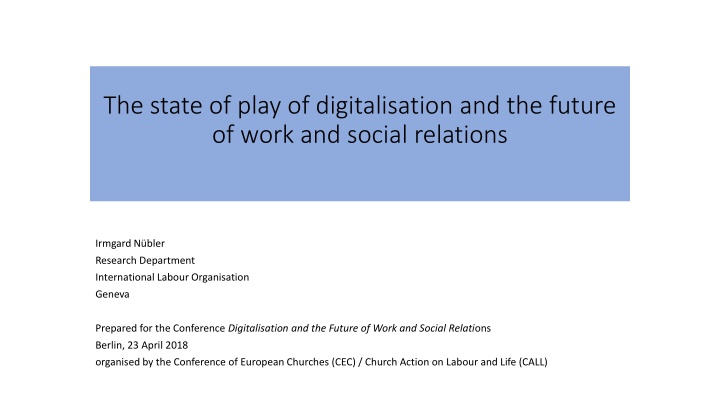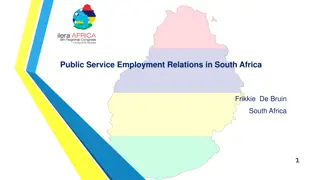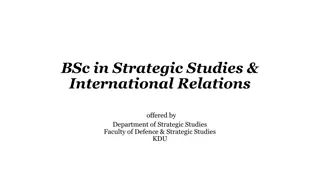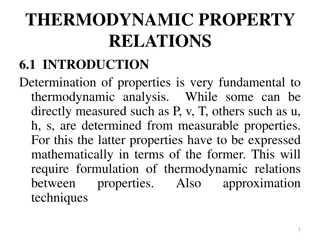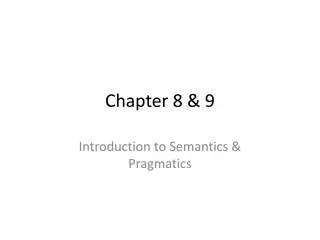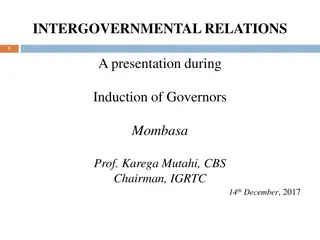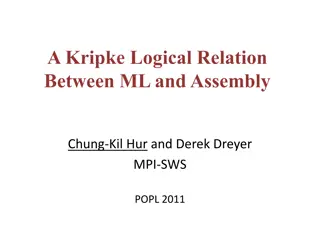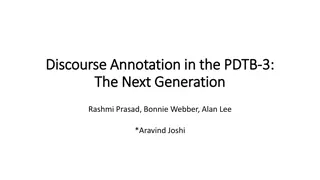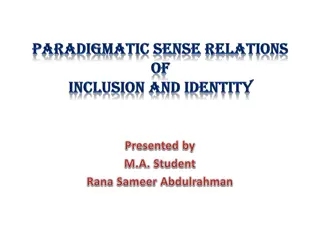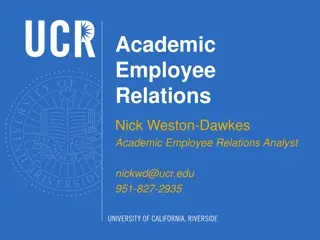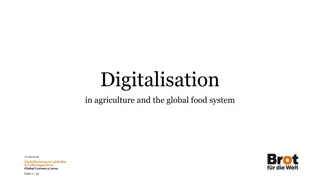The State of Digitalisation and Future Work Relations
Investigating the impact of digitalisation on industrial production systems, technological change dynamics, and employment relationships within the context of regulatory frameworks and historical evolution of work structures.
Download Presentation

Please find below an Image/Link to download the presentation.
The content on the website is provided AS IS for your information and personal use only. It may not be sold, licensed, or shared on other websites without obtaining consent from the author.If you encounter any issues during the download, it is possible that the publisher has removed the file from their server.
You are allowed to download the files provided on this website for personal or commercial use, subject to the condition that they are used lawfully. All files are the property of their respective owners.
The content on the website is provided AS IS for your information and personal use only. It may not be sold, licensed, or shared on other websites without obtaining consent from the author.
E N D
Presentation Transcript
The state of play of digitalisation and the future of work and social relations Irmgard N bler Research Department International Labour Organisation Geneva Prepared for the Conference Digitalisation and the Future of Work and Social Relations Berlin, 23 April 2018 organised by the Conference of European Churches (CEC) / Church Action on Labour and Life (CALL)
Outline of presentation I. A framework to explain technological change and future of work Industrial production system Dynamics of technological change (creative destruction) Social Capabilities II. Digitalisation what it means Major trends in world of work Changing employment relationships III. Shaping the future of work
I. A framework to I. A framework to analyse analyse technological change and the future of jobs technological change and the future of jobs Understanding of industrial production systems (production, training and work) 1. Industrial Revolution (250 years ago) introduced new production mode, shifting production from: workshop to factories, customized to standardized products production for subsistence, particular client and community to production for the markets competition in design and problem solution to competition in prices and quality Market competition resulted in high quest for productivity increase and competitiveness which guided the search for new technologies and innovation behavior. Market forces became important drivers of technological change and innovation In capitalistic system (private ownership of production factors ) the accumulation of financial, physical and human capital resulted in unequal distribution of productivity gains, income and wealth
I. A framework to I. A framework to analyse analyse technological change and the future of jobs technological change and the future of jobs 2. New institutions emerged that regulated the new production system, training and employment relationship Regulatory framework of the guilds defining the strict rules that governed the crafts sector, its training saystem and relationships between the master craftsperson, journeymen and workers, did not cover new factories which were organised outside of this framework. New legal regulation or contractualization of the employment relationship began to emerge in European countries in the latter half of the nineteenth century. shaping the legal distinction between employment and self-employment. defines standard forms of employment which is full time and indefinite work. part of a subordinate and bilateral employment relationship, gives management the power to direct labour and to organise work. New laws regulated education and training systems with large differences across countries Banning or weakening guilds destroyed apprenticeship systems and shifted responsibility for training from enterprise sector to governments and workers (e.g. England, USA, France) Countries which reformed their enterprise-based apprenticeship system while building up formal education developed a shared responsibility between enterprises, governments and workers (e.g. D, CH, AT, DK).
I I. A framework to . A framework to analyse analyse technological change and the future of jobs technological change and the future of jobs The dynamics of technological change and impact on world of work within the industrial and capitalistic production system: non-linear, comes in waves and sequences; recurrencies creative destruction, increasing complexity 1. Process innovations: job destruction, inequality, technological anxiety competitive market pressures drive search for new technologies to enhance productivity Two long-term trends in process innovations Automation - robots Fragmentation of production systems globalization 2. Product innovation: job creation, new institutions, new demand, technological optimism Market expansion in existing products Diversification into new products and jobs creation. New consumer, Leisure-related goods and services New capital goods industries, robots; New infrastructure R&D sector; Education, training sector 4. The transition period into a Golden Age of job creation not automatic, but needs to be shaped Markets alone could not achieve such transformative changes. Societies to generate new social consensus on the way forward in technological change Social movements, new social demand, new institutions and new political choices
I. Capabilities determine a societys competences to innovate, manage change and drive transition into a Golden Age of job creation Such dynamic capabilities enable countries to innovate, develop new good, services, industries shape productive transformation, new jobs and decent work exist in the knowledge base of society (not in skills of individuals) are a collective phenomenon Building up capabilities is a process of societal learning, which enriches and transforms knowledge base.
I. The nature and carriers of dynamic capabilities I. The nature and carriers of dynamic capabilities The particular mix of technical, vocational, professional skills and knowledge (diversity, complexity, specificity of the knowledge base) determines the possible patterns of structural change, incremental differentiation and leapfrogging the type of new technologies and innovations that can be adopted the range of feasible new products that can potentially be produced Regional-specific mindsets, spirits (e.g. precision, design, craftsmanship; entrepreneurship ) created through dominant activities performed in the past and inherited from past generations endow regional labor force with specific competences drives innovations and product diversification along these knowledge paths example: cuckoo clock in 18th century Black Forest and precision industry today. Commonly shared belief systems (culture, ideologies, religion, philosophies) determine choices, attitudes, values; align individual behavior and choices; develops joint visions of the way forward, the development goals and aspirations (example: consumer society in the US A since1930s) Institutions (rules and enforcement mechanisms), restrict individual behavior, create regularities and trust, reduce transaction costs promote investment, innovation, risk taking, and managing change and risks
II. Digitalisation: The current wave of technological change 1971: introduction of micro-processor launched the era of digitisation Rising computer power Sophisticated algorithms New information & communication technologies (internet, social media, GPS) New transport technologies (drones, self-driving cars) Artificial intelligence (Big data and self-improving algorithms) Autonomous robots Smart production systems (industry 4.0)
II. Digitalisation: The impact on the world of work Jobs destruction, creation and employment Productivity Wages Changes in occupational structures Inequality Nature of new economies and jobs Working conditions Employment relationship Non-standard forms of employment (NSFE)
II. Impact on jobs and distribution of productivity gains Technology, job destruction, and inequality Impacts of technological changes? Declining cost of digital technology After the earlier episode of technological pessimism, a more balanced analysis of net job losses (e.g., job destruction rates have been declining Growing concerns about the distribution of productivity gains Note: Job destruction rate is a weighted average of Australia, Belgium, Canada, Denmark, France, Greece, Ireland, Italy, Japan, Luxembourg, Netherlands, Sweden, United Kingdom and United States Source: ILO, Labour Flows database, 2013; tenure rates: OECD, Labour Force Statistics
II. Wage productivity II. Wage productivity gaps gaps Wage repression (wage deflation) and growing inequality (falling labour income share), which is associated with the previous wave of technological changes Figure. Wage-productivity gaps G20 5 4 3 in per cent 2 1 0 2006 2007 2008 2009 2010 2011 2012 2013 2014 2015 -1 Real wage growth Productivity growth G20 advanced G20 emerging 4 10 3 8 in per cent 2 in per cent 6 1 4 0 2 2006 2007 2008 2009 2010 2011 2012 2013 2014 2015 -1 0 -2 2006 2007 2008 2009 2010 2011 2012 2013 2014 2015 Real wage growth Productivity growth Real wage growth Productivity growth Source: ILO, Global Employment Trends, Nov 2017; Global Wage Report 2016-17
II. Job II. Job Polarisation Polarisation: past and projection : past and projection And occupational inequality increased almost everywhere Note: Change in employment shares, in percentage points; *: forecasts after 2016 Source: ILO, Trends Econometric Models, Nov 2016
II. II. Changing Changing Employment Employment relationship Non Non- -standard standard forms forms of relationship: : Increase of employment employment Increase in in Multi-party employment relationship Temporary employment Disguised employment/ dependent self-employment Part-time and on-call work NSE can be either formal or informal
II. II. Temporary Temporary employment employment 35.0 2004 2014 30.0 25.0 20.0 15.0 10.0 5.0 0.0 80.00 60.00 40.00 20.00 0.00 circa 2004 circa 2013
II. Part II. Part- -time time wage wage employment employment Less than 35 h a week MEN [0,10] (10,20] (20,30] (30,40] (40,50] No data WOMEN [0,10] (10,20] (20,30] (30,40] (40,50] No data
II. Multi-party employment relationship World Employment Confederation largest markets: United States, China, Europe, and Japan Republic of Korea: TAW - 4.4% of wage employees; in-house subcontracting - 55% of firms The Philippines: agency-hired workers - 62% of firms South Africa: labour brokering - 6.5% of workforce India: 1/3 of manufacturing workers in organized sector are contract labourers
II. Disguised employment / dependent self- employment Slovakia: 3.6% of employed are false self-employed Chile: 12 17 % of subcontracting firms made up of former employees Argentina: 2.3% of workers Mexico: 4.1% of workers United States: 8 -13 per % of workers in construction Businesses in the on-demand or gig economy hire independent contractors Approximately 0.5% of labour force in U.S. and Europe, but potential for growth is high
II. Crowdwork Crowdwork ( (platform Hourly Hourly earnings earnings distribution platform- -based distribution based tasks tasksperformed performedon on demand demand): ): High inefficiencies: of workers time is on unpaid activities lack of communication between employer and worker Lack of social protection Lack of training 18
III. Shaping the future of work III. Shaping the future of work What needs to be done? 1. While we know the past trends, the future is uncertain, and we may not imagine the future innovations, jobs and occupations. We need to adopt frameworks and models that explain the dynamics and patterns of technological change, innovations, diversification. 2. These frameworks suggest that the future of work is not deterministic, but needs to be shaped, and that it needs transformative changes to shape a future we want. 3. Policies and institutions need to find a fair distribution of the benefits and burdens: support workers and enterprises to exploit the opportunities new technologies bring for better work, life and business, and mitigate or prevent the negative impact and unintended effects.
V V. Shaping the future of work . Shaping the future of work Market forces alone cannot achieve such transformative processes. It requires governments and societies to learn and develop new social demand and policy choices. Build capabilities in labour force, entrepreneurs and societies that enable the country to take advantage of emerging technologies, and innovate and transform production structures to create new economies and jobs. Education and training policies is key as it plays a dual role: enriches the knowledge base of society and thus enhances capabilities to innovate fills skills gaps and matches demand with supply once a new activity has been created. Develop social institutions that reward entrepreneurship, craftsmanship to encourage creativity, investment, innovation and new jobs, and redistribute productivity gains created by new technologies to workers for new demand. Design mission-oriented technology, science, innovation and industrial policies to shape the direction of technological and structural transformation for development, employment and social justice. New institutions need to regulate work and protect workers in newly emerging non-standard forms of employment Create social dialogue for new consensus on the way forward, new social demand and policy choices
Thank you Irmgard N bler Email: nubler@ilo.org Skype: Irmgard.nubler Twitter: IrmgardNubler
